12.2. Add Roles to ASP.NET Accounts
| Authentication is the process of identifying a user; authorization is the process of deciding which parts of your application that user can see and interact with. The forms-based security controls and database that comes with Visual Basic 2005 allows you to set authorization for specific users based on their being assigned to a role (such as guest, member, manager, etc). You do so in three steps: create the roles, assign permissions to each role, and then assign users to the roles. Any given user may be in more than one role (e.g., administrator and manager). The permissions you assign to each role may determine access to a page, or may change the content of a given page displayed to members of that role. 12.2.1. Create a New Application with RolesTo demonstrate how to create roles and assign users to those roles, you'll need to create a new application, ASPSecurityRoles. Begin by copying over the web site you used in the previous exercise (FormBasedSecurity), as shown in Figure 12-21. Figure 12-21. Copy web site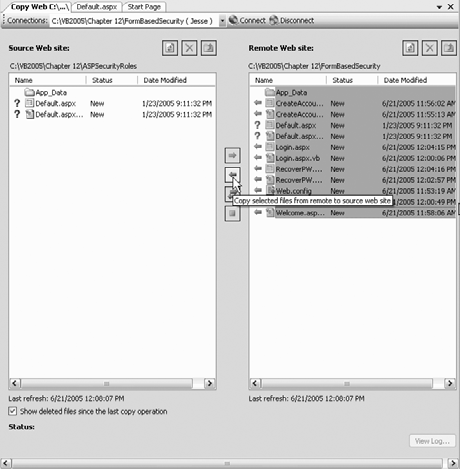 Set Welcome as the Start page and run the program to make sure you can still log in. Open the WAT and click on the Security tab. In the second column (Roles), you'll see that roles are not enabled. Click on Enable Roles, as shown in Figure 12-22. Figure 12-22. Enabling roles in WAT Open Web.config and you'll see that the WAT has updated it to add roles management: <system.web> <roleManager enabled="true" /> <authentication mode="Forms"/> <membership defaultProvider="AspNetSqlMembershipProvider"/> <compilation debug="true"/> </system.web>
Once roles have been created, use the WAT to create your first Role: Manager (it is helpful to have an initial role and a user in that role so that you can have in your code a test to ensure that only Managers, for example, can create new roles or add users to roles).
Under Add/Remove users, click the Manage link and navigate to one of your users (e.g., jliberty) and click the User Is In Role box to add that user to the role, as shown in Figure 12-23. Using the LoginView's smart tag, click on Edit Templates and edit the Logged In Template. Add three hyperlinks to the Logged In Template on the Welcome page, as shown in Figure 12-24. Set the NavigateURL to ChangePW.aspx, CreateAccount.aspx, and ManageRoles.aspx, respectively. Be sure to click on End Template Editing when you are done. Create the ChangePW.aspx page and drag a ChangePassword control onto the page. Use the smart tag to format the ChangePassword control, as shown in Figure 12-25. Set the ContinueDestinationPageURL property to Login.aspx, and on Login.aspx make sure the ContinueDestinationPageURL of the Login control is set to Welcome.aspx. You may also want to confirm or change the Success Text as well as the other text fields (ChangePasswordTitleText, ChangePasswordFailureText, etc.) Figure 12-23. Adding users to roles in WAT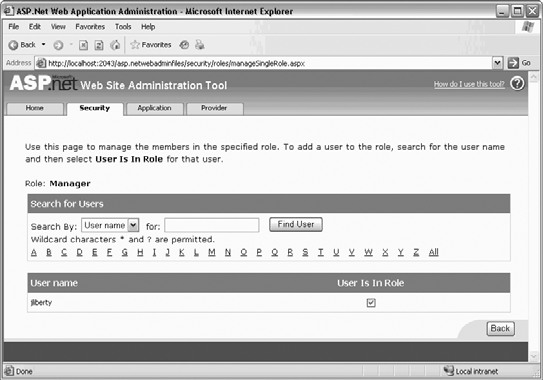 Figure 12-24. End Template Editing of Logged In Template Figure 12-25. ChangePassword control Create the ManageRoles.aspx page. This new page has a somewhat complex layout since it must display the list of roles and the list of users supported by your site, as well as which users have been assigned which roles. The page is shown in Figure 12-26, and the controls are listed in Table 12-1. Figure 12-26. ManageRoles.aspx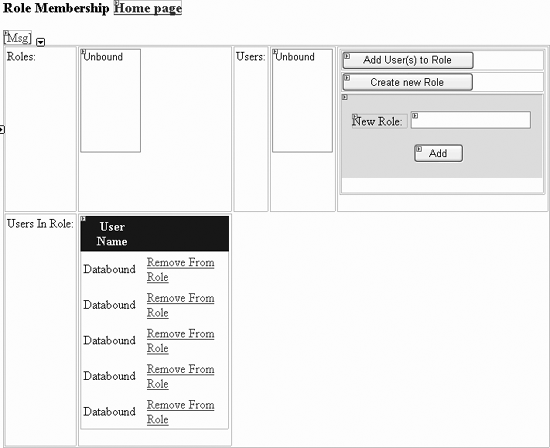
The UsersInRoleGrid should look like Example 12-2. Example 12-2. UserInRoleGrid source<asp:GridView runat="server" CellPadding="4" AutoGenerateColumns="false" Gridlines="None" CellSpacing="0" OnRowCommand="UsersInRoleGrid_RemoveFromRole"> <HeaderStyle BackColor="navy" ForeColor="white" /> <Columns> <asp:TemplateField HeaderText="User Name"> <ItemTemplate> <%# Container.DataItem.ToString( ) %> </ItemTemplate> </asp:TemplateField> <asp:ButtonField Text="Remove From Role" ButtonType="Link" /> </Columns> </asp:GridView> All of these controls should be laid out in a table, with the text inserted into columns as well. The finished page is shown in Example 12-3. Example 12-3. Manage Role Page source<%@ Page Language="VB" AutoEventWireup="false" CodeFile="ManageRoles.aspx.vb" Inherits="ManageRoles_aspx" %> <!DOCTYPE html PUBLIC "-//W3C//DTD XHTML 1.1//EN" "http://www.w3.org/TR/xhtml11/DTD/ xhtml11.dtd"> <html xmlns="http://www.w3.org/1999/xhtml" > <head runat="server"> <title>Manage Roles</title> </head> <body> <form runat="server"> <h3>Role Membership <asp:HyperLink Runat="server" NavigateUrl="Welcome.aspx"> Home page </asp:HyperLink> </h3> <asp:Label ForeColor="maroon" runat="server" /><BR> <table CellPadding="3" border="0"> <tr> <td valign="top">Roles:</td> <td valign="top" style="width: 186px"> <asp:ListBox runat="server" Rows="8" AutoPostBack="True" /> </td> <td valign="top">Users:</td> <td valign="top"> <asp:ListBox DataTextField="Username" Rows="8" SelectionMode="Multiple" runat="server" /> </td> <td valign="top" visible="false"> <table> <tr> <td> <asp:Button Text="Add User(s) to Role" runat="server" OnClick="AddUsers_OnClick" /> </td> </tr> <tr> <td> <asp:Button Text="Create new Role" runat="server" OnClick="CreateRole_OnClick" Width="170px" Height="24px" /> </td> </tr> <tr> <td> <asp:Panel Runat="server" Width="259px" Height="79px" Visible="False" BackColor="#E0E0E0"> <br /> <asp:Label Runat="server" Text="New Role:" Width="72px" Height="19px"/> <asp:TextBox Runat="server"/> <br /> <br /> <asp:Button Runat="server" Text="Add" OnClick="btnAddRole_Click" Width="64px" Height="24px" /><br /> </asp:Panel> </td> </tr> </table> </td> </tr> <tr> <td valign="top">Users In Role:</td> <td valign="top" style="width: 186px"> <asp:GridView runat="server" CellPadding="4" AutoGenerateColumns="false" Gridlines="None" CellSpacing="0" OnRowCommand="UsersInRoleGrid_RemoveFromRole"> <HeaderStyle BackColor="navy" ForeColor="white" /> <Columns> <asp:TemplateField HeaderText="User Name"> <ItemTemplate> <%# Container.DataItem.ToString( ) %> </ItemTemplate> </asp:TemplateField> <asp:ButtonField Text="Remove From Role" ButtonType="Link" /> </Columns> </asp:GridView> </td> </tr> </table> </form> </body> </html>
The code-behind page must implement five event handlers:
Your class will declare three member variables:
The MembershipUserCollection is defined by the Framework to hold MembershipUser objects (surprise!). A MembershipUser object, in turn, is defined by the Framework to represent a single user in the membership data store (in this case, the tables created in SqlServerExpress). This class exposes information about the user such as the user's email address, and methods such as those needed to change or reset the user's password. Here's how the code works. The first step is to override the Page_Load event handler, as shown in Example 12-4. Example 12-4. Page_Load Protected Sub Page_Load( _ ByVal sender As Object, _ ByVal e As System.EventArgs) Handles Me.Load If User.IsInRole("Manager") = False Then Response.Redirect("NoPrivs.aspx") End If Msg.Text = String.Empty If Not IsPostBack Then rolesArray = Roles.GetAllRoles( ) RolesListBox.DataSource = rolesArray RolesListBox.DataBind( ) users = Membership.GetAllUsers( ) UsersListBox.DataSource = users UsersListBox.DataBind( ) End If If (RolesListBox.SelectedItem IsNot Nothing) Then usersInRole = Roles.GetUsersInRole(RolesListBox.SelectedItem.Value) UsersInRoleGrid.DataSource = usersInRole UsersInRoleGrid.DataBind( ) End If End Sub First check that the current user is a manager. If he is, a redirect to an error page: If User.IsInRole("Manager") = False Then Response.Redirect("NoPrivs.aspx") End If If this is the first time you are displaying the page, get the rolls and bind them to the list box, then get all the users and bind that collection to the Users List Box: If Not IsPostBack Then rolesArray = Roles.GetAllRoles( ) RolesListBox.DataSource = rolesArray RolesListBox.DataBind( ) users = Membership.GetAllUsers( ) UsersListBox.DataSource = users UsersListBox.DataBind( ) End If If there is a selected item in the Roles List Box, get the list of users who are in that role and bind the list to the users in Roll Grid: If (RolesListBox.SelectedItem IsNot Nothing) Then usersInRole = Roles.GetUsersInRole(RolesListBox.SelectedItem.Value) UsersInRoleGrid.DataSource = usersInRole UsersInRoleGrid.DataBind( ) End If Step 2 is to implement the AddUsers_OnClick event handler, as shown in Example 12-5. Example 12-5. AddUsers_OnClick handlerProtected Sub AddUsers_OnClick( _ ByVal sender As Object, _ ByVal e As System.EventArgs) Handles btnAddUsersToRole.Click ' A role must be selected If RolesListBox.SelectedItem Is Nothing Then Msg.Text = "Please select a role." Exit Sub End If ' At least one user must be selected If UsersListBox.SelectedItem Is Nothing Then Msg.Text = "Please select one or more users." Exit Sub End If ' Create list of users to be added to the selected role Dim sizeOfArray As Integer = UsersListBox.GetSelectedIndices.Length Dim newUsers(sizeOfArray - 1) As String 'For i As Integer = 0 To newusers.Length - 1 ' newusers(i) = _ ' UsersListBox.Items( _ ' UsersListBox.GetSelectedIndices( )(i)).Value 'Next For i As Integer = 0 To newUsers.Length - 1 ' get the array of selected indices from the (multiselect) list box Dim selectedIndices As Integer( ) = UsersListBox.GetSelectedIndices( ) ' get the selectedIndex that corresponds to the counter (i) Dim selectedIndex As Integer = selectedIndices(i) ' get the ListItem in the UserListBox Items collection at that offset Dim myListItem As ListItem = UsersListBox.Items(selectedIndex) ' get the string that is that ListItem's value property Dim newUser As String = myListItem.Value ' add that string to the newUsers collection of string newUsers(i) = newUser Next ' Add users to the selected role Roles.AddUsersToRole(newUsers, RolesListBox.SelectedItem.Value) usersInRole = Roles.GetUsersInRole(RolesListBox.SelectedItem.Value) UsersInRoleGrid.DataSource = usersInRole UsersInRoleGrid.DataBind( ) End Sub First, check to make sure that a role has been selected: If RolesListBox.SelectedItem Is Nothing Then Msg.Text = "Please select a role." Exit Sub End If At least one user should be selected: If UsersListBox.SelectedItem Is Nothing Then Msg.Text = "Please select one or more users." Exit Sub End If Create an array to hold the users to be added: Dim sizeOfArray As Integer = UsersListBox.GetSelectedIndices.Length Dim newusers(sizeOfArray - 1) As String Iterate through the users, retrieving each selected user's name: For i As Integer = 0 To newusers.Length - 1 newusers(i) = _ UsersListBox.Items( _ UsersListBox.GetSelectedIndices( )(i)).Value Next This statement is pretty complicated. The best way to understand it is to rewrite it using interim variables, like this: For i As Integer = 0 To newUsers.Length - 1 ' get the array of selected indices from the (multiselect) list box Dim selectedIndices As Integer( ) = UsersListBox.GetSelectedIndices( ) ' get the particular selectedIndex that corresponds to the counter (i) Dim selectedIndex As Integer = selectedIndices(i) ' get the ListItem in the UserListBox Items collection at that offset Dim myListItem As ListItem = UsersListBox.Items(selectedIndex) ' get the string that is that ListItem's value property Dim newUser As String = myListItem.Value ' add that string to the newUsers collection of string newUsers(i) = newUser Next The advantage of the interim variables is that you can set break points on them and see what their value is, and you can more easily document the code. The disadvantage is minimal, but many programmers (especially those from the "C" culture!) still prefer the terser version. Next, call the static AddUsersToRole on the Roles class, passing in the array of usernames, and the role you want these users added to. Rebind the users who are in that role to the UsersInRoleGrid: Roles.AddUsersToRole(newUsers, RolesListBox.SelectedItem.Value) usersInRole = Roles.GetUsersInRole(RolesListBox.SelectedItem.Value) UsersInRoleGrid.DataSource = usersInRole UsersInRoleGrid.DataBind( ) As noted earlier, step 3 is to implement UsersInRoleGrid_RemoveFromRole as shown in Example 12-6. Example 12-6. UsersInRoleGrid_RemoveFromRoleProtected Sub UsersInRoleGrid_RemoveFromRole( _ ByVal sender As Object, _ ByVal e As System.Web.UI.WebControls.GridViewCommandEventArgs) _ Handles UsersInRoleGrid.RowCommand ' get the user to remove Dim index As Integer = Convert.ToInt32(e.CommandArgument) Dim username As String = _ CType(UsersInRoleGrid.Rows(index).Cells(0).Controls(0), _ DataBoundLiteralControl).Text ' remove the user Roles.RemoveUserFromRole(username, RolesListBox.SelectedItem.Value) ' Rebind the users in role to Gridview usersInRole = Roles.GetUsersInRole(RolesListBox.SelectedItem.Value) UsersInRoleGrid.DataSource = usersInRole UsersInRoleGrid.DataBind( ) End Sub Step 4 is to add the Create Role_OnClick event handler, which makes the CreateRole panel visible, as shown in Example 12-7. Example 12-7. CreateRole button Click event handlerProtected Sub CreateRole_OnClick ( _ ByVal sender As Object, _ ByVal e As System.EventArgs) Handles btnCreateRole.Click pnlCreateRole.Visible = True End Sub The purpose of this is to present the panel, which contains a text box for the user to enter a new role and an Add button, as shown in Figure 12-27. Figure 12-27. Create new role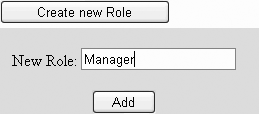 Finally, implement the btnAddRole_Click event handler, shown in Example 12-8. Example 12-8. AddRole button Click event handlerProtected Sub btnAddRole_Click( _ ByVal sender As Object, _ ByVal e As System.EventArgs) Handles btnAddRole.Click If txtNewRole.Text.Length > 0 Then Dim newRole As String = txtNewRole.Text ' if the role does not already exist, add it ' rebind the roles list box If Roles.RoleExists(newRole) = False Then Roles.CreateRole(newRole) rolesArray = Roles.GetAllRoles( ) RolesListBox.DataSource = rolesArray RolesListBox.DataBind( ) End If End If txtNewRole.Text = String.Empty pnlCreateRole.Visible = False End Sub Check to make sure there is text in the NewRole text box, and then check to make sure the role does not exist. If it does not, create the new role using the Shared CreateRole method of the Roles class, provided by the Framework.
Get all the roles by calling the Shared method GetAllRoles and store the roles in the member array rolesArray, to which you bind the list box. When the role is added, the text box is cleared and the panel is made invisible. Run the application and click on Manage Roles to add a couple of roles. Next, click on a role (to highlight it) and highlight one or more users; then click Add User(s) to Role. The results are shown in Figure 12-28. Figure 12-28. Adding users to roles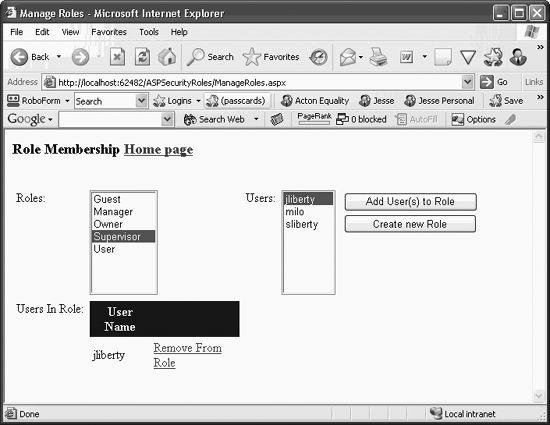 Add each user to one or more roles. 12.2.2. Restricting Access to Pages Based on RolesThere are two ways to restrict access to a page based on membership in a Role. The first is to test if the logged-in user is in a particular role, using the User.IsInRole( ) method: Dim isManager as boolean = User.IsInRole("Manager") You might redirect the user to an error page if the user is not in the required role. As an example, let's add code that blocks nonmanagers from linking to the Manage Roles page. To do so, add a test in the Page_Load method of ManageRoles.aspx.vb: Protected Sub Page_Load( _ ByVal sender As Object, _ ByVal e As System.EventArgs) Handles Me.Load If User.IsInRole("Manager") = False Then Response.Redirect("NoPrivs.aspx ") End If If the user is not in the role of "Manager," the user is redirected to the page NoPrivs.aspx. That page can display an error message and then allow the user to take other actions. A very simple example is shown in Figure 12-29. Figure 12-29. NoPrivs.aspx The code for the button (btnHome) on the NoPrivs.aspx.vb page, whose text is "Return to Welcome," is very simple and shown in Example 12-9. Example 12-9. Return to Welcome button Click event handler .Protected Sub btnHome_Click( _ ByVal sender As Object, _ ByVal e As System.EventArgs) Handles btnHome.Click Response.Redirect("Welcome.aspx") End Sub 12.2.3. Restricting Access to a Set of PagesYou can also restrict access to a set of pages by adding an authorization section to a Web.config file. You place this file in a subdirectory to control access to all files in that subdirectory and all of its subdirectories, and you use the location element to control access to specific files: <authorization> <deny users='?' /> <allow roles='Manager' /> <deny users='*' /> </authorization> The first line (deny users = '?') prohibits access to anyone who is not logged in. The second line (allow roles='Manager') allows access to anyone in the Manager role, and the final line (deny users='*') disallows everyone, but is overridden by the allow roles. |
EAN: 2147483647
Pages: 162
- ERP System Acquisition: A Process Model and Results From an Austrian Survey
- The Second Wave ERP Market: An Australian Viewpoint
- The Effects of an Enterprise Resource Planning System (ERP) Implementation on Job Characteristics – A Study using the Hackman and Oldham Job Characteristics Model
- Context Management of ERP Processes in Virtual Communities
- A Hybrid Clustering Technique to Improve Patient Data Quality
- Key #2: Improve Your Processes
- Key #4: Base Decisions on Data and Facts
- Making Improvements That Last: An Illustrated Guide to DMAIC and the Lean Six Sigma Toolkit
- The Experience of Making Improvements: What Its Like to Work on Lean Six Sigma Projects
- Six Things Managers Must Do: How to Support Lean Six Sigma
